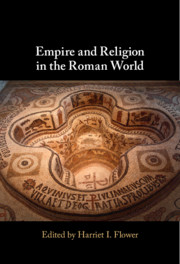Book contents
- Empire and Religion in the Roman World
- Empire and Religion in the Roman World
- Copyright page
- Frontispiece
- Contents
- Figures
- Table
- Contributors
- Acknowledgments
- Introduction
- Part I Empire
- Chapter 1 Germs and Empire
- Chapter 2 Imperial Integration on Rome’s Atlantic Rim
- Chapter 3 The Ambitions of Government
- Chapter 4 Contingency and Context
- Part II Religion
- Appendix: Bibliography of Brent D. Shaw’s Publications to 2020
- Index
- References
Chapter 1 - Germs and Empire
The Agency of the Microscopic
from Part I - Empire
Published online by Cambridge University Press: 26 August 2021
- Empire and Religion in the Roman World
- Empire and Religion in the Roman World
- Copyright page
- Frontispiece
- Contents
- Figures
- Table
- Contributors
- Acknowledgments
- Introduction
- Part I Empire
- Chapter 1 Germs and Empire
- Chapter 2 Imperial Integration on Rome’s Atlantic Rim
- Chapter 3 The Ambitions of Government
- Chapter 4 Contingency and Context
- Part II Religion
- Appendix: Bibliography of Brent D. Shaw’s Publications to 2020
- Index
- References
Summary
This chapter explores the state of knowledge about the Antonine Plague, an empire-wide pandemic that struck from the mid-160s. It emphasizes that even against the backdrop of the unhealthy environment of the Roman empire, the Antonine Plague stood out as an extraordinary event in its geographical scope and biological impact. The stories of the Roman armies introducing the plague on their return from the Parthian campaign deserve greater scrutiny, as they are likely colored by imperial propaganda concerning Avidius Cassius and Lucius Verus, but the notion that the disease was caused by a pathogen carried into the Roman empire from without, likely along Red Sea and Indian Ocean trading routes, is plausible.
- Type
- Chapter
- Information
- Empire and Religion in the Roman World , pp. 13 - 34Publisher: Cambridge University PressPrint publication year: 2021



